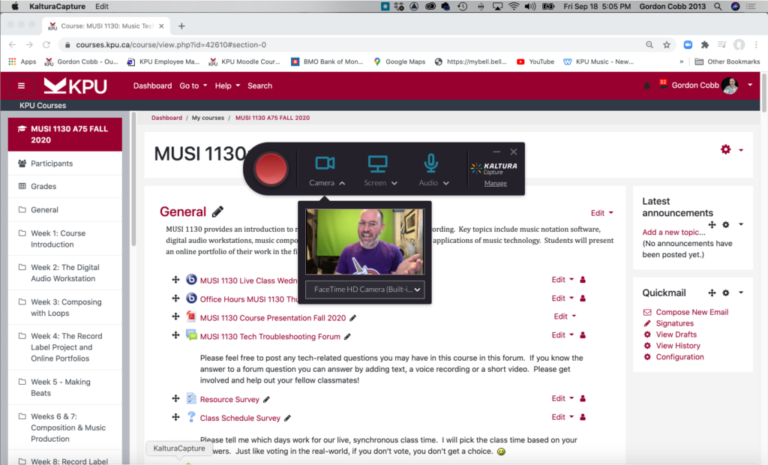Video Conferencing Tools
This past year, maintaining communication with students, and sustaining student engagement, proved challenging. Conferencing tools, previously reserved for the odd administrative meeting or symposium presentation, suddenly became a vital tool for many of KPU’s faculty and instructional staff. When the shift to remote teaching first occurred, KPU educators had two conferencing tools at their disposal, BigBlueButton, which was designated as the teaching and learning conferencing tool to be used with students, and the IT department supported Microsoft Teams software for department meetings.
With the sudden influx of new users, we quickly outgrew our server. On March 23, 2020, the Teaching and Learning Commons announced that BigBlueButton was moving servers to address bandwidth issues and that Microsoft Teams had been approved for use with students. Simultaneously, many KPU faculty and instructional staff asked to use Zoom, with many being comfortable in Zoom spaces as the primary method of connecting with family and friends during the pandemic. Many months later, after ensuring that student data would be safely stored on a Canadian server, Zoom was introduced as another conferencing tool as an option to be used for teaching and learning at KPU. Although there were now more choices, the problem became when to use these tools, and for what?
Conferencing tools can be used to support pedagogy. They can allow educators to engage with their students in real-time if the barriers to their use are addressed, including the confidence and skills required to use them effectively. Enter stage right, the Conferencing Tools Pressbook and Harnessing the Power of Conferencing Tools Workshop series that we created and hosted. These resources have been created to support best practices for using all three of KPU’s conferencing tools and optimizing our students’ experiences.
Chris knows first-hand how these tools, when used well, can optimize interactions and experiences, and he should, as his onboarding experience has solely lived in these spaces. Here he reflects on how a New York Times article (Nguyen, 2021) and his own experience allowed him to evaluate the untapped potential of conferencing tools to humanize our virtual interactions:
Having joined KPU in November 2020, I am a relatively new member of the KPU Teaching and Learning Commons team. While getting started, one of the most common phrases I heard were variations of: “It is hard to get used to a new job, but with everything online, it must be that much more difficult.” As any new job is a bit overwhelming, I quickly and heartily agreed, but as time passed, it became clearer to me that perhaps some of these ‘online’ issues were not as difficult as first thought; and in fact, meeting and working with new people in these virtual spaces provided a quicker path to connection than if we were together in ‘normal’ workspaces.
First, video conferencing tools have often connected us from our most intimate environments – the home. As such, there are inevitable glimpses into others’ lives as they are. Barking dogs, beeping delivery trucks and odd noises from family members or roommates all quickly elicit apologies and understanding from all involved. This level of consistent graciousness only comes from a shared experience where control has been usurped, and mistakes or missteps are not only forgiven but empathized with. We have been there or have been the cause of something similar ourselves.
What has been equally interesting has been that many of the foibles and errors are not necessarily connected to one’s skill level but with the nature of software and computing. For example, bandwidth issues cause delays and glitches that impede communication or upset the planned process. Even the most experienced Zoom user can click one too many times when a perceived action does not produce the intended result in a timely fashion. This, in turn, can lead to over-correction or unneeded fixes, thus becoming an impediment in and of themselves. While ‘speed’ and ‘lack of error’ are often hallmarks of an ‘expert’, for online facilitation, those two benchmarks might better be replaced by ‘patience’ and ‘comfort making mistakes’.
As observed previously, most reaction to this has always been one of understanding and, quite often, encouragement. It reminds me of watching a live show where an actor or musician makes a mistake but deals with it and goes on with the show. The crowd finds unity in its acceptance and understanding, and it is often these moments of error and support that are more fondly talked about, so than flawless performances. As our Learning Technology Manager, Leeann would say, “We need to model vulnerability.”
Dr. Viet Thanh Nguyen’s (2021) New York times article confessing that he likes teaching on Zoom helped me to explore further the possibility that these platforms were not deficient in creating positive, humanized educational environments. His more detailed defence of this position held many similarities to my onboarding at Kwantlen. His observation that these tools had “Less human warmth, but more human connection” said it best. That isn’t to say that I didn’t feel the warm welcome from everyone I met, but that I got know a lot more about my co-workers from one-on-one video calls than if we were making small talk at work. Nguyen’s point about seeing names on the screen made it easier to engage directly and better remember a more significant number of people compared to only hearing names in introductions, like in most physical settings.
Whether it has been for onboarding, department meetings, conferences, or hosting workshops, Chris and I have become comfortable in all KPU’s conferencing spaces. We want you to join us and explore how you can harness the power of these conferencing tools and use them to elevate your online practices.
Nguyen, V. T. (2021, February 15). I Actually Like Teaching on Zoom. The New York Times – Breaking News, US News, World News and Videos. https://www.nytimes.com/2021/02/15/opinion/zoom-video-school-teaching.html?searchResultPosition=1






